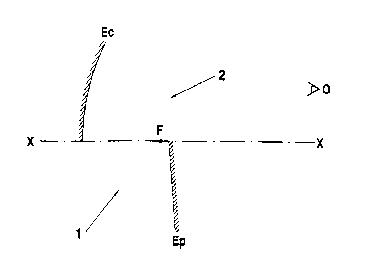Some of the information on this Web page has been provided by external sources. The Government of Canada is not responsible for the accuracy, reliability or currency of the information supplied by external sources. Users wishing to rely upon this information should consult directly with the source of the information. Content provided by external sources is not subject to official languages, privacy and accessibility requirements.
Any discrepancies in the text and image of the Claims and Abstract are due to differing posting times. Text of the Claims and Abstract are posted:
| (12) Patent Application: | (11) CA 2286434 |
|---|---|
| (54) English Title: | OPTICAL SYSTEM CAPABLE OF CREATING THE THREE-DIMENSIONAL IMAGE ON AN OBJECT IN SPACE WITHOUT IMAGE INVERSION |
| (54) French Title: | SYSTEME OPTIQUE PERMETTANT DE CREER L'IMAGE TRIDIMENSIONNELLE D'UN OBJET DANS L'ESPACE SANS INVERSION D'IMAGE |
| Status: | Deemed Abandoned and Beyond the Period of Reinstatement - Pending Response to Notice of Disregarded Communication |
| (51) International Patent Classification (IPC): |
|
|---|---|
| (72) Inventors : |
|
| (73) Owners : |
|
| (71) Applicants : |
|
| (74) Agent: | SMART & BIGGAR LP |
| (74) Associate agent: | |
| (45) Issued: | |
| (22) Filed Date: | 1999-10-14 |
| (41) Open to Public Inspection: | 2000-04-16 |
| Availability of licence: | N/A |
| Dedicated to the Public: | N/A |
| (25) Language of filing: | English |
| Patent Cooperation Treaty (PCT): | No |
|---|
| (30) Application Priority Data: | ||||||
|---|---|---|---|---|---|---|
|
The optical system comprises a convergent mirror (E c) and a
plane mirror (E p), which are duly positioned in order for the focus (F)
established in the optical axis (X-X) of the convergent mirror (E c) in
turn to be located in the sector lying between both mirrors. An object
(I1-I2) located in an area (1) is first reflected onto the plane mirror (E p)
and then onto the convergent mirror (E c), yielding an image (I''1-I''2) in
an area (2) opposite the area (1) in a normal position for an observer
located at a point (O) outside the system, i.e. in such a position that the
signs are legible.
Note: Claims are shown in the official language in which they were submitted.
Note: Descriptions are shown in the official language in which they were submitted.

2024-08-01:As part of the Next Generation Patents (NGP) transition, the Canadian Patents Database (CPD) now contains a more detailed Event History, which replicates the Event Log of our new back-office solution.
Please note that "Inactive:" events refers to events no longer in use in our new back-office solution.
For a clearer understanding of the status of the application/patent presented on this page, the site Disclaimer , as well as the definitions for Patent , Event History , Maintenance Fee and Payment History should be consulted.
| Description | Date |
|---|---|
| Inactive: IPC expired | 2020-01-01 |
| Inactive: IPC expired | 2020-01-01 |
| Inactive: IPC from MCD | 2006-03-12 |
| Application Not Reinstated by Deadline | 2003-10-14 |
| Time Limit for Reversal Expired | 2003-10-14 |
| Deemed Abandoned - Failure to Respond to Maintenance Fee Notice | 2002-10-15 |
| Letter Sent | 2001-12-28 |
| Inactive: Entity size changed | 2001-12-28 |
| Reinstatement Requirements Deemed Compliant for All Abandonment Reasons | 2001-12-07 |
| Deemed Abandoned - Failure to Respond to Maintenance Fee Notice | 2001-10-15 |
| Application Published (Open to Public Inspection) | 2000-04-16 |
| Inactive: Cover page published | 2000-04-16 |
| Inactive: Filing certificate - No RFE (English) | 2000-02-18 |
| Request for Priority Received | 2000-01-27 |
| Inactive: Filing certificate correction | 1999-12-13 |
| Inactive: First IPC assigned | 1999-11-26 |
| Inactive: Filing certificate - No RFE (English) | 1999-11-18 |
| Filing Requirements Determined Compliant | 1999-11-18 |
| Letter Sent | 1999-11-16 |
| Inactive: Inventor deleted | 1999-11-10 |
| Inactive: Inventor deleted | 1999-11-10 |
| Application Received - Regular National | 1999-11-09 |
| Inactive: Applicant deleted | 1999-11-09 |
| Inactive: Applicant deleted | 1999-11-09 |
| Abandonment Date | Reason | Reinstatement Date |
|---|---|---|
| 2002-10-15 | ||
| 2001-10-15 |
The last payment was received on 2001-12-07
Note : If the full payment has not been received on or before the date indicated, a further fee may be required which may be one of the following
Please refer to the CIPO Patent Fees web page to see all current fee amounts.
| Fee Type | Anniversary Year | Due Date | Paid Date |
|---|---|---|---|
| Application fee - small | 1999-10-14 | ||
| MF (application, 2nd anniv.) - standard | 02 | 2001-10-15 | 2001-12-07 |
| Reinstatement | 2001-12-07 |
Note: Records showing the ownership history in alphabetical order.
| Current Owners on Record |
|---|
| JUAN DOMINGUEZ-MONTES |
| JESUS MARCOS GOMEZ-MARTIN |
| JOSE MARIA CIENFUEGOS-JOVELLANOS |
| Past Owners on Record |
|---|
| None |